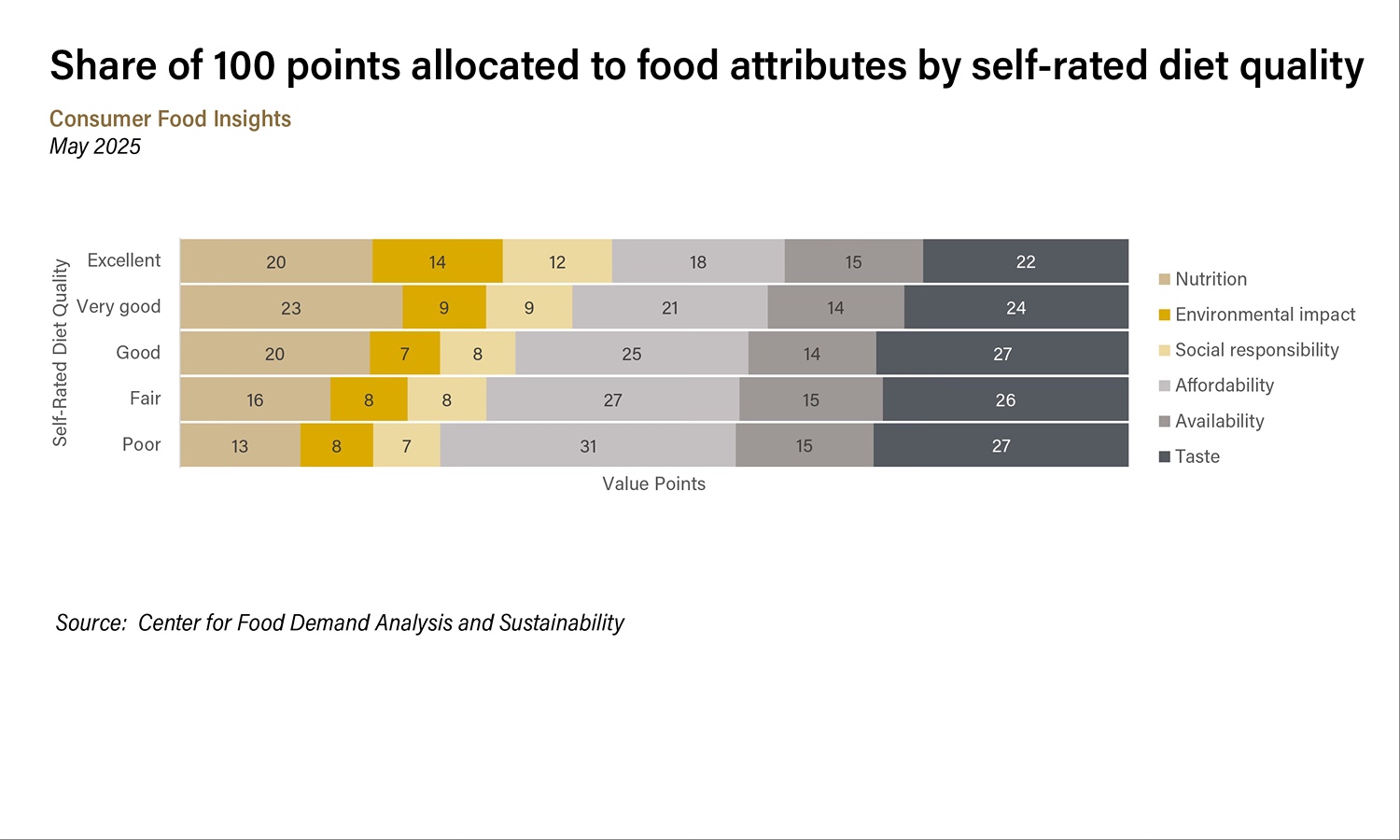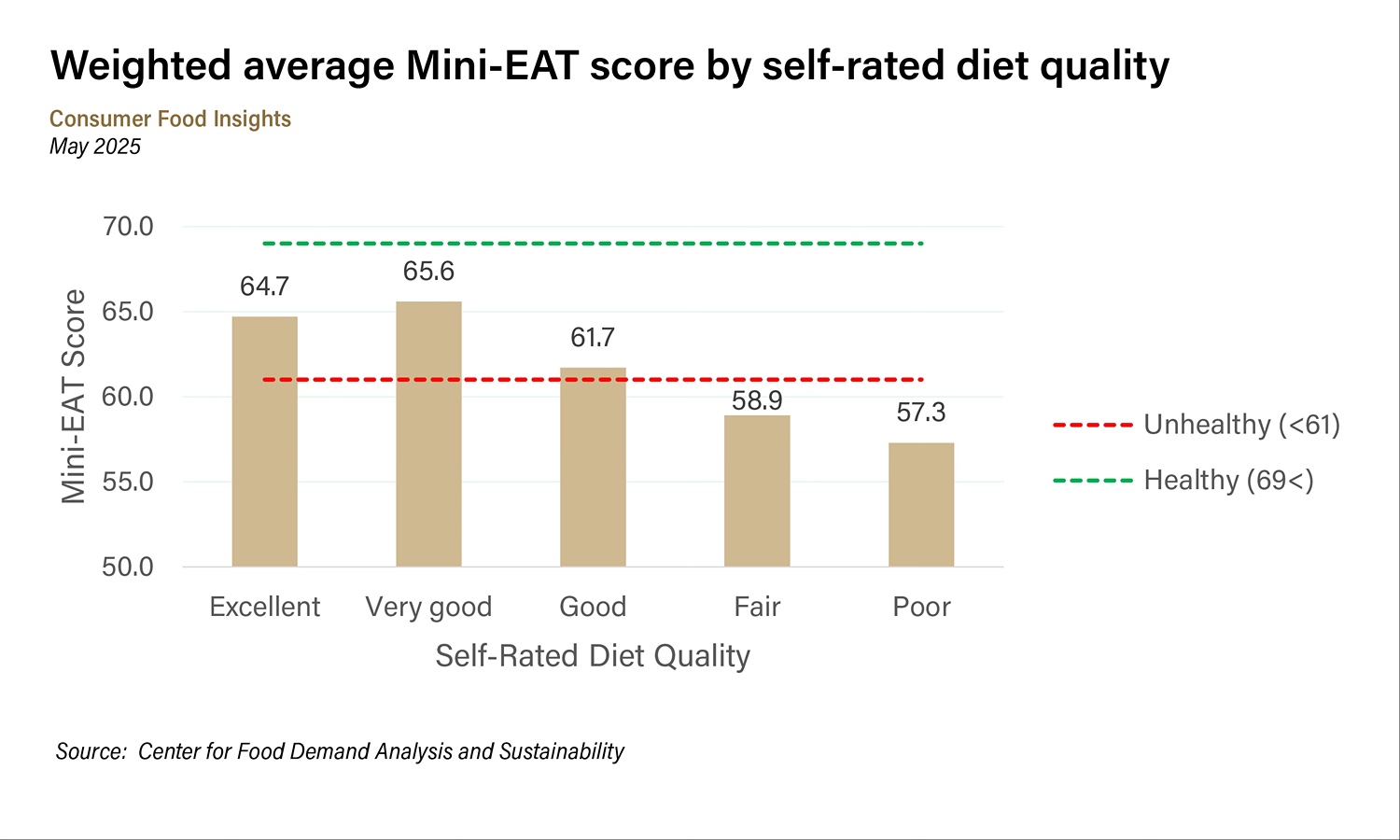Consumers follow unhealthy diets despite apparently knowing better
WEST LAFAYETTE, Ind. — Consumers seem confident in their ability to identify healthy foods and understand that what they eat directly influences their overall health. Even so, new data shows that the average American adult has an unhealthy diet, according to the May Consumer Food Insights Report (CFI).
The survey-based report from Purdue University’s Center for Food Demand Analysis and Sustainability (CFDAS) assesses food spending, consumer satisfaction and values, support of agricultural and food policies, and trust in information sources. Purdue experts conducted and evaluated the survey, which included 1,200 consumers across the U.S.
The May edition explores consumer perceptions of and preferences for healthy foods. CFDAS conducted last month’s survey during a national media discussion that spotlighted issues related to health and the use of GLP-1 for weight control and blood-sugar regulation.
“We wanted to dive into this topic to understand what ‘healthy food’ really means to consumers and what foods they look for at the store to meet this need,” said the report’s lead author, Joseph Balagtas, professor of agricultural economics at Purdue and director of CFDAS.
“We also sought to understand their beliefs related to the connection between a good diet and a healthy lifestyle.”
“Our research shows that consumers care about nutrition, but that they prioritize taste first and foremost, and then price and availability,” Balagtas said. That means consumers may pass on healthy diets and foods that are not also tasty and affordable.
Overall, most consumers agree (76%) that their health depends on the foods they eat every day and that improving their diet is usually the best way to start improving their health (81%). However, many consumers report facing challenges to improving their diets. People who rate their diets as “fair” or “poor” are more likely to say that it’s not easy to find healthy foods where they live, and that it is difficult to judge healthfulness from food labels.
The Food and Drug Administration is working to define a “healthy” label that would be placed on food products to indicate they comply with what is considered healthy by the agency. “Perhaps this label will help consumers to make more informed choices when purchasing foods at the store,” Balagtas said.
The food attributes that consumers consider in their grocery purchasing decisions have remained steady. Taste, affordability and nutrition top the list, while environmental impact and social responsibility remain relatively low, said Elijah Bryant, a survey research analyst at CFDAS and a report co-author.
“When grouping consumers by their self-rated diet quality, we see differences in points allocated to each food attribute, as well as the overall ranking of attributes between those who place their diets on the highest and lowest ends of the scale,” Bryant said. “Overall, those who value taste and affordability at the expense of nutrition tend to report having poorer diets. Notably, the difference across ratings is most drastic within the allocation to affordability.”
American adult diet quality remains relatively unchanged from April. Individuals who rate their diet as “fair” or “poor” tend to consume food that is less aligned with nutritional guidelines.
Consumer food inflation estimates also remain relatively unchanged from April, at just under 5%. The survey results did show an increase in consumers’ weekly at-home (grocery) spending of $7 compared to April. Weekly away-from-home (restaurant) spending remained unchanged from April. The consumer price index measure of food inflation declined 0.3 points based on recent data from the Bureau of Labor Statistics. This comes after a gradual rise in food inflation since October 2024.
The survey revealed a 2-point increase in food insecurity from April to 15% in May. This remains within recent variations that CFDAS researchers have seen in the monthly food insecurity rate.
“Contrary to what one may expect, we observe a decent share of those who are food insecure — 32% — reporting ‘excellent’ or ‘very good’ diet health,” Bryant said. “Further investigation reveals that much of this is driven by young respondents who rate their diet high but also report food insecurity.”
Since both quality and quantity are components of food security, this raises the question of whether this result is mostly driven by a lack of resources to buy enough food among this population. “Around 37% of those who are food insecure also report fair or poor diet quality,” Bryant said.
In the consumer behaviors category, those who rate the health of their diets as being “excellent” or “very good” tend to check food labels more frequently. These consumers also tend to more frequently purchase foods with specialty production attributes, including organic, local and grass fed, Bryant said.
The Center for Food Demand Analysis and Sustainability is part of Purdue’s Next Moves in agriculture and food systems and uses innovative data analysis shared through user-friendly platforms to improve the food system. In addition to the Consumer Food Insights Report, the center offers a portfolio of online dashboards.
About Purdue Agriculture
Purdue University’s College of Agriculture is one of the world’s leading colleges of agricultural, food, life and natural resource sciences. The college is committed to preparing students to make a difference in whatever careers they pursue; stretching the frontiers of science to discover solutions to some of our most pressing global, regional and local challenges; and, through Purdue Extension and other engagement programs, educating the people of Indiana, the nation and the world to improve their lives and livelihoods. To learn more about Purdue Agriculture, visit this site.
About Purdue University
Purdue University is a public research university leading with excellence at scale. Ranked among top 10 public universities in the United States, Purdue discovers, disseminates and deploys knowledge with a quality and at a scale second to none. More than 106,000 students study at Purdue across multiple campuses, locations and modalities, including more than 57,000 at our main campus locations in West Lafayette and Indianapolis. Committed to affordability and accessibility, Purdue’s main campus has frozen tuition 14 years in a row. See how Purdue never stops in the persistent pursuit of the next giant leap — including its integrated, comprehensive Indianapolis urban expansion; the Mitch Daniels School of Business; Purdue Computes; and the One Health initiative — at https://www.purdue.edu/president/strategic-initiatives.
Writer: Steve Koppes
Media contact: Devyn Ashlea Raver, draver@purdue.edu
Sources: Joe Balagtas, balagtas@purdue.edu; Elijah Bryant, ehbryant@purdue.edu
Agricultural Communications: Maureen Manier, mmanier@purdue.edu, 765-494-8415
Journalist Assets: Publication quality charts and images image can be obtained at this, link






